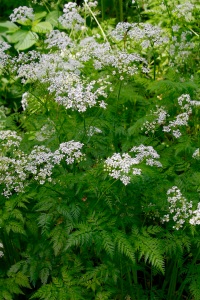The biennial primarily germinates in the spring and fall, but seedlings can emerge throughout the growing season. Plants flower in 2nd year. Flowering stems are stout, hairless, hallow, ridged, up to 10′ tall, and branch extensively. Lower stem and branches have distinctive reddish-purple markings.
CAUTION: All parts of the plant are toxic especially the roots and seeds. Environmental factors can affect the concentration of poisonous alkaloids. Do no ingest any part of this plant.
Legal classification in Wisconsin: Prohibited/Restricted
Leaves: Stem leaves are 8-16″ long, triangular in outline, alternate, pinnately compound 3-4 times, shiny, hairless, and parsley-like. The leaves, when crushed, emit a musty odor reminiscent of mice. Rosette leaves are similar to leaves found on the stem.
Flowers: Late spring to midsummer. White, arranged in broad umbels 1.5-2.5″ across. Umbels are found at the end of stems and are comprised of 12-16 smaller flowers.
Fruits and seeds: Fruit composed of two seeds. Seeds are approximately 0.11-0.16″ in length, ridged, and flattened on one side.
Roots: White taproot
Similar species: Queen Anne’s lace (Daucus carota) has no reddish-purple markings on the stem, hairy leaves, and larger, less rounded umbels. It is also much shorter than hemlock (1-3′ tall). Cow parsnip (Heracleum lanatum) has palmately compound leaves and lacks reddish-purple coloring on its stem.
Ecological threat:
• Invades disturbed areas, damp areas, ditches, roadsides, railroads, fencerows, and timber lots.
• Seeds are readily transported by water.
• Ingestion of this plant can be fatal to humans and animals.
For more information visit: http://dnr.wi.gov/topic/invasives/fact/poisonhemlock.html
Photo released under creative commons license.
